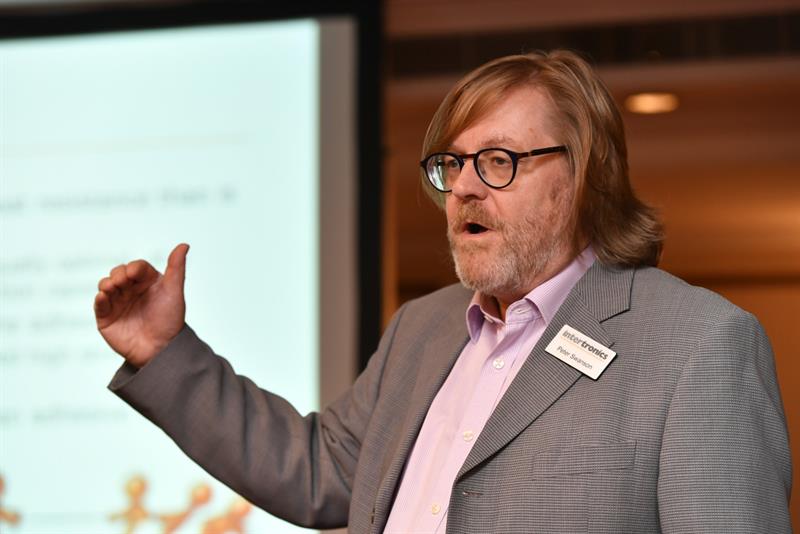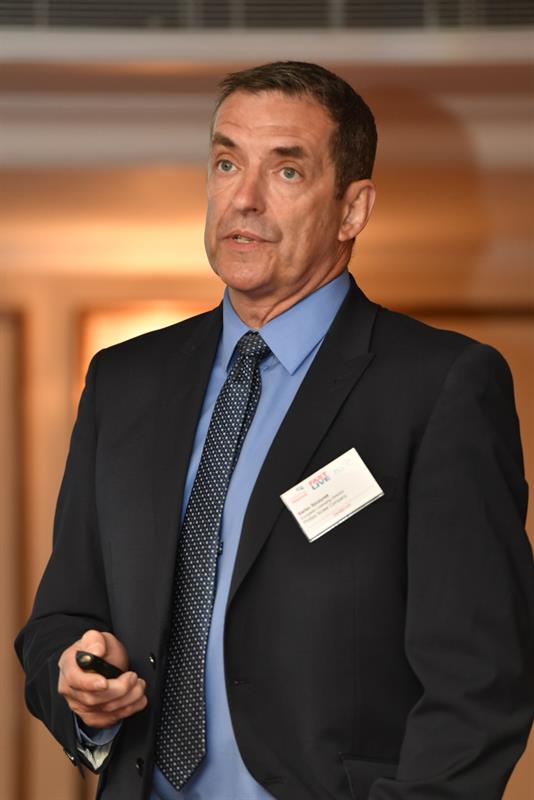As well as the many stands, manned by specialists willing and ready to discuss their latest products and how they could help solve specific design challenges, the seminar sessions are a great way to get more in-depth information. This year’s line-up was no different.
With an increasing number of structural adhesives on the market, choosing the right one can be a headache. Peter Swanson, managing director of Intertronics, was there to clarify the matter in his seminar.
The use of adhesives to provide a structural bond instead of mechanical fasteners can provide advantages, including performance and reliability improvements, and reduction in manufacturing costs. However, Swanson began: “There is no such thing as a perfect adhesive. Inevitably, compromises are going to be made.”
Starting with design and working through production and processing considerations, he discussed the various factors which influence the decisions of engineers, and how to develop a specification based on the necessary priorities and allowable compromises.
 According to Swanson, the questions designers should be asking themselves before even putting pen to paper or firing up their CAD software include: What materials are you bonding together? Are there joint design considerations that will give better strength? Do the surfaces need to be prepared, and how? Do you need to be able to quality assess the part once it’s assembled, and how? How will you get the adhesive to where it needs to be and how will you cure it?
According to Swanson, the questions designers should be asking themselves before even putting pen to paper or firing up their CAD software include: What materials are you bonding together? Are there joint design considerations that will give better strength? Do the surfaces need to be prepared, and how? Do you need to be able to quality assess the part once it’s assembled, and how? How will you get the adhesive to where it needs to be and how will you cure it?
Another tip he offered is not to pick an adhesive with more strength or heat resistance than needed, as this can make the product more costly or difficult to process. Also, a very important part of the process is proper testing, not just relying on what data sheets say.
“I strongly recommend you must test on production parts,” Swanson said. “Data sheets are fine, but they are from lab tests, not the real world. Each application is unique and all
have different needs, requirements and priorities. Work with a good supplier – someone who has experience working with these kinds of materials. Someone who understands, not just adhesives, but how they work in the industrial environment and what sort of equipment must be used and also somebody who knows the stuff that isn’t on the data sheets and can help you with all the testing and evaluation you might need to make it work.”
Stefan Szczurek, European licensing director of Phillips Screw Company, offered a different opinion: “Bonding with adhesive is great because it takes fasteners out of the equation,” he said. “But it limits access, reparability and recyclability. With a threaded joint you have ease of access for service, ease of removal and repair and you can completely disassemble for recycling.”

Companies in the aerospace industry such as Rolls-Royce, Airbus and Boeing are constantly seeking weight reductions. Phillips, a supplier to these companies, has refined its fastener designs to be smaller and lighter with reduced head height while retaining their strength.
Szczurek gave an in-depth look into why contact surface area is critical in assuring torque transfer and joint strength, and how to optimise design for lightweight field serviceability.
Essentially, screw head contact area has evolved from a slot, to square, to cross-recess, which can be shaped to handle multiple and asymmetric loads. Slotted screws only have two lines of contact at the edges of the driver, square drives have four, and a cross-recess – like Phillips’ Mortorq design – provides even greater contact and self-centring ability.
“Our Mortorq system has large contact areas on both sides of the recess and a larger contact surface area on the removal wall than the installation wall, providing ease of maintenance and the ability to remove fasteners more easily,” said Szczurek.
“Because we’ve been able to increase the contact surface area we can reduce the depth of the recess in the fastener. As a general rule, the penetration depth of a recess has to be 40% of the recesses dimeter. Our Mortorq system is up to 50% shallower, meaning we can reduce the head height by 15-25%. This gives an advantage when you’ve got difficult to reach areas and also when you’re looking at weight reduction.”
This has realised a 15kg weight reduction per 1,000 pieces.
Recently, Facebook has joined the aerospace realm with its Aquila drone that is designed to stay in the air for months at a time at 60-70,000 feet, beaming internet to remote areas or disaster zones. As such, it requires extremely strong yet lightweight fasteners to join the wings (which are the same length as a 747’s) the fuselage.
“The fastener we’ve designed for them hasn’t gone into full production just yet, but they will do within the next year or so,” Szczurek said.
FAST Live will next be held at the Imperial War Museum, Duxford on 20 September 2018, co-located with Engineering Materials Live.











